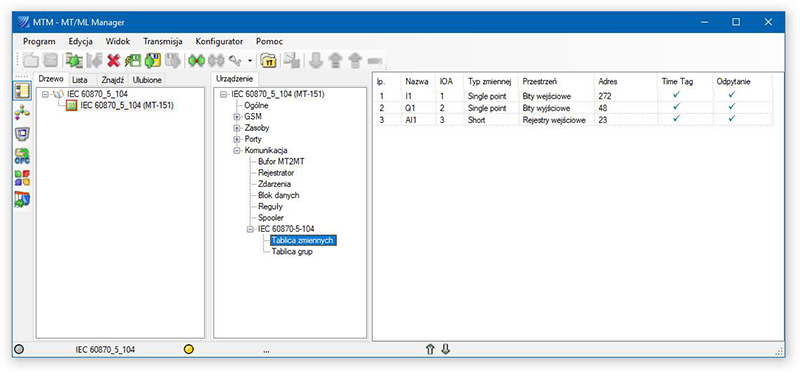Implementation of the IEC 60870-5-104 protocol in MT-151
The communication capabilities of the MT-151 modules working as a Slave device (Server) have been extended by the implementation of IEC 60870-5-104 protocol (abbreviated as IEC 104). It is a network protocol based on TCP / IP and is used in telematic and telemetry systems in power engineering.

Implementation of this protocol in the MT-151 module allows handling one TCP / IP client. The module listens on port 2404. The IEC protocol has been adapted based on the structure of Modbus registers, which limits the data types to a single bit (single point), a single 16-bit signed register (short scaled) and a variable with a floating decimal point written in the dual register (short float). We provide a full description of the implemented functions in the form of an interoperable table.
By default, over 8,000 registers are available for the IEC 104 protocol. They are divided into four blocks forming a table of IEC variables. The user can access each MT-151 LED register by calling the “read variable” function (C_RD_NA_1) with the correct IOA address. The module responds by the value from the corresponding Modbus register/bit.
Also, the module configuration allows for the definition of a maximum of 200 variables in the IOA address range from 1 to 1000. Each variable can be given a type and assign the address or bit appearing in the memory map, which is to be accessed through the IEC 104 protocol. Each variable may have a unique name, be marked with a time stamp and can be marked as a global variable provided in response to a global query (interrogation).
The global query is carried out by the command (C_IC_NA_1), which contains an additional parameter determining whether it is a global question (general) or asking for a specific group. The module provides eight groups of parameters to which individual variables can be assigned. Polling groups using the global read command requires the appropriate identifier for a particular group 1 – 8.

The module can also spontaneously send data based on the definitions of an event table. Each of the available 32 events has its trigger condition and the assigned data to send. They can be single variables or groups. Events can also be sent via the internal program after selecting the P1 – P256 flag as the trigger source. IEC events are independent of the classic events sent by the module.
The IEC 104 protocol allows to synchronize RTC of client with server time. By default this functionality is inactive, but the module configuration allows you to enable time synchronization over IEC protocol.





